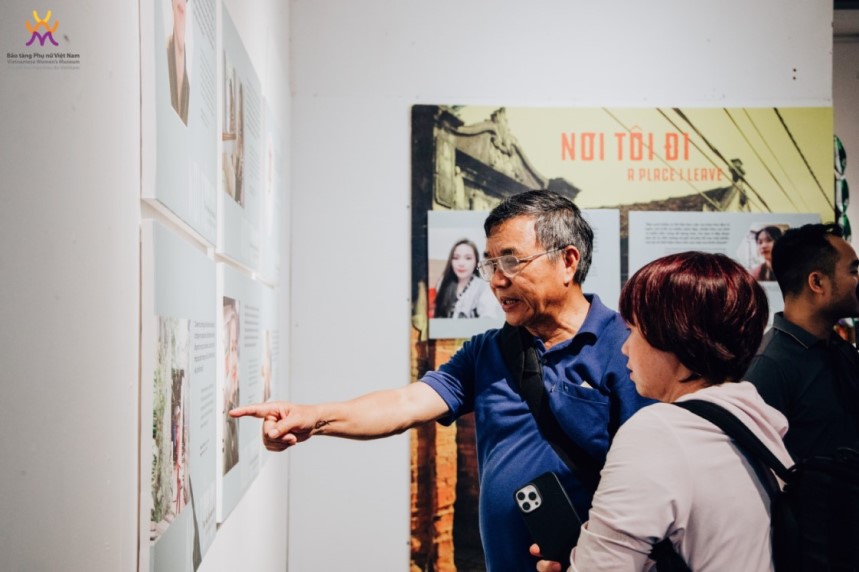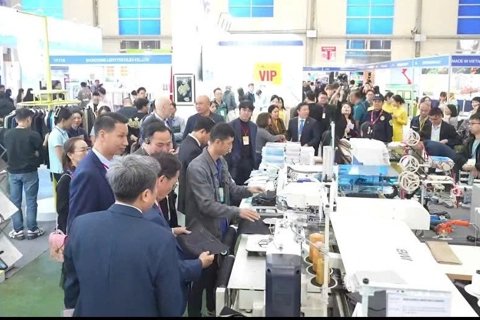Stories behind female immigrant workers in Hanoi
Migrants are a source of labor and a driving force for socio-economic development.
Street vendor Le Thi Hoa stopped for a long time in front of her photo displayed at the exhibition Where I Arrive. She was overwhelmed with emotion when her story was told this way.
The exhibition is held by the Vietnamese Women's Museum with a group of female migrant workers in Hanoi.
Stories to be heard
For the exhibition, the museum staff met and interviewed 20 female migrant workers aged 16-34 from various occupations, including waitresses, hairdressers, salespersons, chefs, waste collectors, and street vendors in the capital city. They come from other provinces, including Son La, Cao Bang, Phu Tho, Hung Yen, Hai Phong, Nam Dinh, Thanh Hoa, Nghe An, and Ha Tinh, with hopes for a better future.
| Le Thi Hoa and guests at the exhibition. Photo courtesy of the museum. |
Museum's director Nguyen Thi Tuyet told The Hanoi Times that every nation experiences migration, an inevitable trend, a positive driving force for socio-economic development, and a source of labor for the economy.
"They come from different areas throughout the country, but they have one thing in common: Facing difficult circumstances in the city. We wanted to find answers to our questions: What barriers and challenges have they faced, especially in using public spaces? How have they adapted to the way of life and community here? What are they after?"
The answers to these questions are found through the tales of female migrant workers told in the exhibition through photo materials, short films, and stories shared.
The exhibition is divided into three areas that discuss the journey of female migrant workers who left the countryside, where they live to find livelihoods and their daily life pressures.
Le Thi Hoa, a 31-year-old woman from the central province of Thanh Hoa, works as a street vendor in Hanoi. Hoa is the second child in a family of three siblings. Her parents are farmers. She left school in her ninth grade in 2005 to move to Hanoi. She often starts to work from 8 am to 11 pm every day. Her income is about VND4 million (US$200) per month.
She felt moved when visitors looked at the photos, carefully read her stories, and showed empathy. She appreciated the museum for the exhibition, which is expected to increase people’s awareness of the challenges and dreams of immigrants.
"Whether we live in the city or the countryside, we are all Vietnamese. I hope people sympathize with and show more respect to street vendors like us,” she said.
Do Thi Tuoi, 33, a shoeshiner from Thanh Hoa, has lived in Hanoi for 15 years. She has rented a 10sq.m room for her stay. She leaves her rented 10-square-meter room at 6 am every day and returns home after 6 pm. In addition to shoe polishing, she works part-time jobs, such as house cleaning, to earn about VND10 million ($450) monthly.
"I wander through Hanoi's streets all day long. I frequently encounter and experience discrimination from certain city dwellers, so I sincerely hope that everyone has a similar perspective and is sympathetic to employees from rural areas like myself," she said.
Her only dream is to earn enough money to support her two children's education. So they will have a better future than hers. As her husband works away from home, Tuoi's mother now looks after her children.
| The opening ceremony of the exhibition. Photo courtesy of the museum |
Support migrant women
According to the Vietnam Women's Union, women continue to make up the majority of migrants (55.5%). Some 61.8% of the migrants are in the age range of 20 to 39.
"It is evident that migrant women play a significant role in the labor force and in the economic development of cities and industrial zones. When it comes to job and family life, they do, however, face more obstacles and hurdles than males,” said Nguyen Thi Minh Huong, vice president of the Vietnam Women's Union.
Huong expressed her wish that through this event, the Vietnam Women's Union would get suggestions on improving activities to create a safe living and working environment for women.
In recent years, the Vietnam Women's Union has worked with other departments to propose policies, programs, and projects to support migrant women, such as: supporting female migrant workers with children under 36 months old in child care, mobilizing social resources to build safe communities; implementing models of safe communities, safe villages, and safe vehicles for women and children; establishing groups/clubs to attract migrant women.
Huong also urged everyone to join hands to create good conditions for these women to realize their full potential and equitably access services.
| The exhibition helps people understand more the work of female immigrants. Photo: Ngo Minh |
Ambassador of Canada to Vietnam, Shawn Steil, highly appreciated the exhibition and research on female immigrants. It's an opportunity to improve the livability, inclusivity, and friendliness of Vietnamese cities for everyone, especially the most vulnerable and migrants.
He stressed the need to make people aware of the growing need for more high-quality public spaces in light of Hanoi's rapid development. “According to our experience in global urban planning, it is essential to increase living space while considering the needs of the most vulnerable people. In this way, we can make the city livable and meet the needs of all," he said.
The exhibition is displayed at the Vietnamese Women's Museum, 36 Ly Thuong Kiet Street, Hoan Kiem District, Hanoi.














